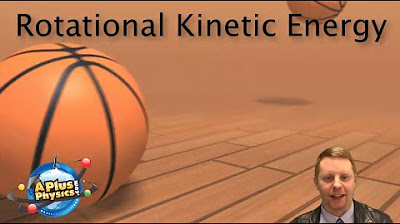AP Physics Lecture on Moment of Inertia. Watch this before 7.E
TLDRThe video script discusses the concept of rotational inertia, its relationship with an object's moment of inertia, and how it affects the rotational motion of objects. It explains through examples of different shapes (hollow and solid) that the more solid an object is, the less moment of inertia it has, and vice versa. The script also illustrates how objects with lower moment of inertia reach higher speeds during rotational motion, using a race as an analogy. The key concept emphasized is that rotational kinetic energy depends on both translational and rotational motion, with the total kinetic energy calculated by summing the two. The video is designed to enhance understanding of rotational inertia for students studying physics.
Takeaways
- 🌀 Rotational inertia is the tendency of an object to resist changes in its state of rotation, analogous to how mass resists changes in linear motion.
- 🔧 The moment of inertia (I) is a measure of an object's rotational inertia and depends on both its mass and the distribution of that mass relative to the axis of rotation.
- 📐 For a solid object, the moment of inertia can be calculated using the formula I = (1/2)MR^2, where M is the mass and R is the radius.
- 🔄 The further the mass is from the axis of rotation, the greater the moment of inertia, meaning the object will be more resistant to changes in its rotation.
- 💫 An object with a hollow or shell-like structure will have a greater moment of inertia compared to a solid object of the same mass.
- 🏎️ In a race scenario, objects with lower moment of inertia will generally reach the bottom of a ramp faster than those with higher moment of inertia, due to their lower rotational kinetic energy.
- 🔌 The rotational kinetic energy is given by the formula KE_rot = (1/2)Iω^2, where ω is the angular velocity.
- 🌡️ The total kinetic energy of an object involves both translational and rotational components and can be expressed as KE_total = (1/2)mv^2 + (1/2)Iω^2.
- 🏢 The moment of inertia for different shapes has specific values: a solid sphere is (2/5)MR^2, a hollow sphere is (2/3)MR^2, a solid cylinder is (1/2)MR^2, and a hollow cylinder is MR^2.
- 📈 The ranking of objects based on their moment of inertia can be used to predict their behavior in rotational motion scenarios, such as which will roll or slide down a ramp first.
- 📚 Understanding the principles of rotational inertia and moment of inertia is crucial for solving problems in physics involving rotational motion.
Q & A
What is rotational inertia?
-Rotational inertia, also known as the moment of inertia, is a measure of an object's resistance to rotational motion. It depends on the mass of the object and how that mass is distributed relative to the axis of rotation.
How does the moment of inertia relate to Newton's second law of motion?
-The moment of inertia is the rotational analog of Newton's second law of motion. While Newton's second law relates force, mass, and linear acceleration (F=ma), the rotational version states that the net torque (which is the rotational equivalent of force) is equal to the moment of inertia multiplied by the angular acceleration (τ=Iα).
What factors affect an object's moment of inertia?
-An object's moment of inertia is affected by its mass and the distribution of that mass relative to the axis of rotation. The more mass is concentrated further away from the axis, the greater the moment of inertia.
Which has a greater moment of inertia: a solid object or a hollow object with the same mass and dimensions?
-A hollow object has a greater moment of inertia compared to a solid object with the same mass and dimensions because the mass in a hollow object is more evenly distributed, which increases its resistance to rotational motion.
What is the formula for calculating the moment of inertia of a hollow sphere?
-The formula for the moment of inertia of a hollow sphere is I = MR^2, where M is the total mass of the sphere and R is the radius of the sphere.
How does the moment of inertia affect an object's rotational kinetic energy?
-The rotational kinetic energy of an object is given by the formula KE_rot = 0.5 * I * ω^2, where I is the moment of inertia and ω is the angular velocity. An object with a larger moment of inertia will have a higher rotational kinetic energy for the same angular velocity.
Why did the ice cube roll down the ramp first in the example given?
-The ice cube rolled down the ramp first because it had no rotational kinetic energy, as it was on a frictionless surface and all its energy was translational. This means it had less total kinetic energy to begin with, allowing it to reach the bottom more quickly than the other objects with greater moment of inertia.
Which object had the least moment of inertia in the ranking provided?
-The solid sphere had the least moment of inertia in the ranking, with a value of 2/5MR^2, making it the fastest object to reach the bottom of the ramp.
What is the relationship between an object's moment of inertia and its speed down a ramp?
-An object with a lower moment of inertia will generally reach the bottom of a ramp faster than an object with a higher moment of inertia, assuming no external forces like friction or air resistance are acting on them. This is because the object with less moment of inertia requires less torque to achieve the same angular acceleration, leading to a quicker descent.
How can you rank different objects based on their moment of inertia?
-You can rank objects based on their moment of inertia by calculating the moment of inertia for each object using the appropriate formula and then comparing the values. The object with the highest moment of inertia will be the slowest, while the one with the lowest will be the fastest in a rotational context.
What are the key concepts to remember about moment of inertia?
-The key concepts to remember about moment of inertia are that it measures an object's resistance to rotation, it depends on the mass distribution relative to the axis of rotation, and it plays a crucial role in determining the rotational kinetic energy and the speed of an object in rotational motion.
Outlines
🌀 Introduction to Rotational Inertia
This paragraph introduces the concept of rotational inertia by using the analogy of a wheel composed of multiple particles at varying distances from the axis of rotation. It explains how the torque applied at different radii contributes to the net torque, which is identified as the moment of inertia. The relationship between the moment of inertia, mass distribution, and angular acceleration is discussed, drawing a parallel to Newton's second law of motion but in the context of rotational motion. The paragraph emphasizes the importance of mass distribution in determining the rotational inertia of an object, with objects having mass concentrated further from the axis of rotation exhibiting greater inertia.
📏 Calculating Moment of Inertia for Different Objects
This section delves into the calculation of the moment of inertia for various objects, such as hollow and solid disks, and compares their values. It highlights the relationship between the physical structure of an object and its moment of inertia, with solid objects having less moment of inertia than their hollow counterparts. The explanation includes the mathematical formulas for calculating the moment of inertia for different shapes, like the thin hoop (1/2 MR^2), solid hoop (2/3 MR^2), and solid sphere (2/5 MR^2), and contrasts these with the hollow sphere. The paragraph also corrects a typo, clarifying that the solid version should have less moment of inertia than the thin version.
🏎️ Ranking Objects Based on Moment of Inertia
This paragraph presents a practical application of moment of inertia by ranking different objects based on this property and predicting their motion down a ramp. The objects include a solid cylinder, solid sphere, spherical shell, and a hollow hoop. The ranking is done from the highest to the lowest moment of inertia, with the hollow hoop having the greatest and the solid sphere having the least. The paragraph then predicts the order in which these objects would reach the bottom of the ramp, with the solid sphere being the fastest and the hollow hoop being the slowest. The explanation is grounded in the concept that an object with less moment of inertia will accelerate faster, leading to it reaching the bottom first.
🔋 Understanding Kinetic Energy in Rotation
The final paragraph focuses on the concept of kinetic energy in the context of rotational motion. It explains the formula for calculating rotational kinetic energy and how it relates to the object's moment of inertia and angular velocity. The paragraph also discusses the total kinetic energy of an object, which is the sum of its translational and rotational kinetic energies. A practical example is given, where the kinetic energies of different objects are calculated to illustrate their velocities. The paragraph concludes by reinforcing the idea that objects with less moment of inertia will have greater translational kinetic energy and thus move faster, which is why the ice cube, having only translational kinetic energy, moves the fastest down the ramp.
Mindmap
Keywords
💡Rotational Inertia
💡Torque
💡Angular Acceleration
💡Moment of Inertia
💡Newton's Second Law of Motion
💡Solid and Hollow Objects
💡Kinetic Energy
💡Translational and Rotational Motion
💡Ramp Experiment
💡Mass Distribution
💡Angular Velocity
Highlights
Rotational inertia can be thought of as the 'resistance' of an object to rotate around an axis.
The moment of inertia is a measure of the rotational inertia of an object and is dependent on the mass distribution relative to the axis of rotation.
The formula for moment of inertia for a hollow cylinder is I = MR^2, where M is the mass and R is the radius.
A solid cylinder has a moment of inertia of I = (1/2)MR^2, indicating a difference in rotational inertia between solid and hollow objects.
The moment of inertia for a solid sphere is I = (2/5)MR^2, which is less than that of a solid cylinder due to the even distribution of mass.
The rotational inertia of an object is directly proportional to its moment of inertia and the angular acceleration is directly proportional to the net torque acting on it.
The moment of inertia is a key concept in understanding the dynamics of rotational motion, similar to how mass is key in translational motion.
The ranking of moment of inertia for different objects can be used to predict their rotational motion and speed.
An object with a lower moment of inertia will generally have a higher rotational speed compared to an object with a higher moment of inertia.
In a race scenario, the object with the least moment of inertia (the solid sphere in this case) reaches the bottom first.
Rotational kinetic energy is given by (1/2)Iω^2, where I is the moment of inertia and ω is the angular velocity.
The total kinetic energy of an object includes both translational and rotational kinetic energy.
The ice cube, having only translational kinetic energy, went down first due to the absence of rotational kinetic energy.
Understanding the relationship between moment of inertia and rotational kinetic energy is crucial for solving problems in rotational dynamics.
The concept of moment of inertia is fundamental in the study of physics, particularly in the area of rotational motion.
For the AP Physics exam, while calculations of moment of inertia may not be required, understanding the concept and its implications is essential.
The more 'solid' or filled an object is, the less moment of inertia it has, and vice versa for 'hollow' or less dense objects.
The moment of inertia is directly related to how an object responds to torque and its subsequent rotational motion.
Transcripts
Browse More Related Video

Moment of Inertia | Physics with Professor Matt Anderson | M12-05

Rotational kinetic energy | Moments, torque, and angular momentum | Physics | Khan Academy

Moment of Inertia Introduction and Rotational Kinetic Energy Derivation

AP Physics 1 - Rotational Dynamics

AP Physics 1 - Rotational Kinetic Energy

College Physics 1: Lecture 25 - Moment of Inertia and Rotational Dynamics
5.0 / 5 (0 votes)
Thanks for rating: